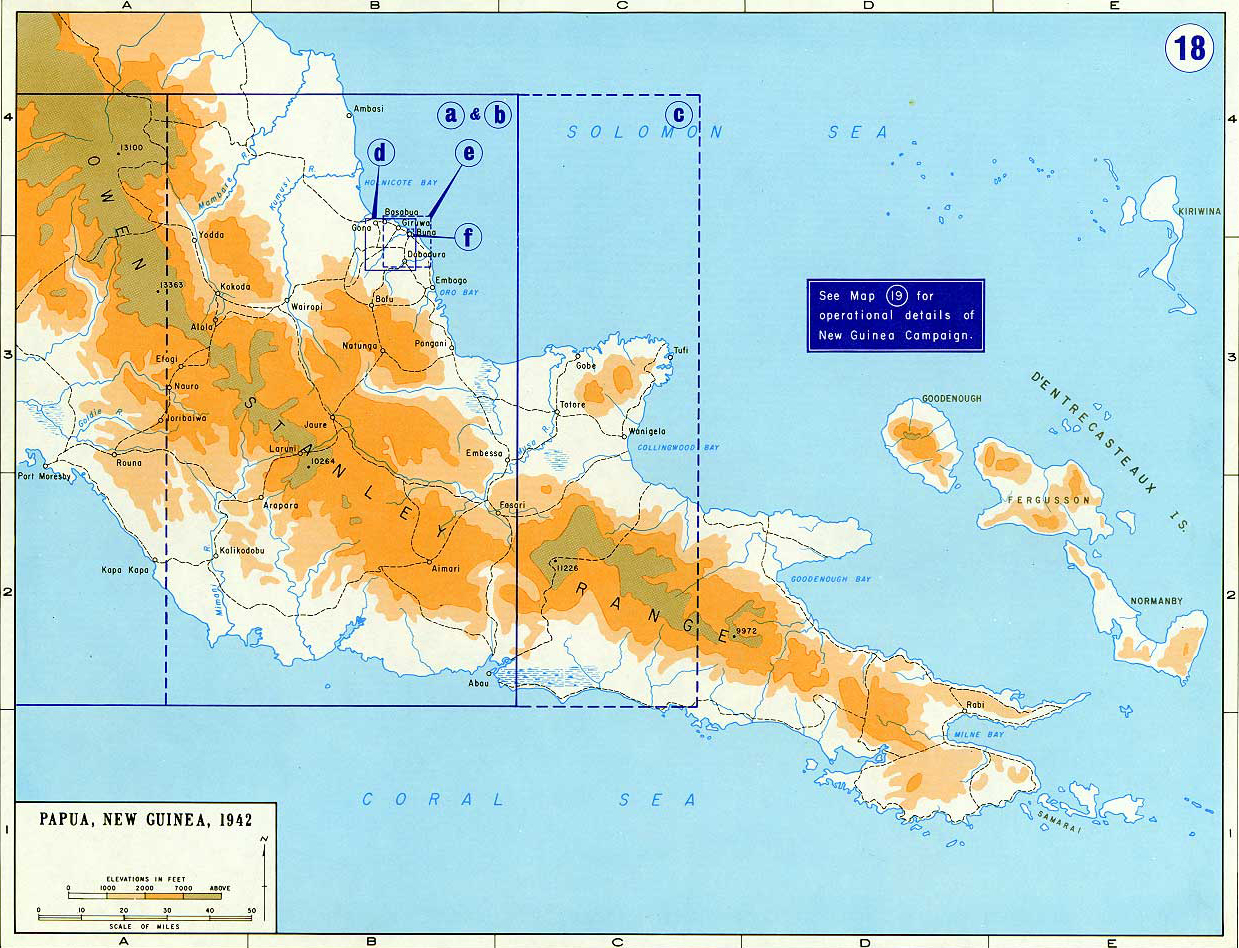Map Description
History Map of WWII: Papua New Guinea 1942
Illustrating:
The Papua New Guinea Campaign (1942–1945)
It follows a brief overview of the Papua New Guinea Campaign.
See this map for operational details of the campaign.
The Papua New Guinea Campaign was a pivotal series of engagements in the Pacific Theater of World War II, marking the first major
defeat of Japanese land forces and playing a critical role in halting Japan’s southward advance toward Australia.
Note: Was Guadalcanal or Papua New Guine first? While Guadalcanal is often remembered as the first major Allied offensive in the Pacific and marked a turning point in World War II, the first clear-cut defeat of Japanese land forces occurred earlier at Milne Bay in Papua New Guinea. From 25 August to 7 September 1942, primarily Australian troops, with U.S. support, successfully repelled a Japanese amphibious assault. This Allied victory at Milne Bay predated the conclusion of the Guadalcanal campaign, which had begun on 7 August 1942 but continued until 9 February 1943. Thus, Milne Bay was the first major, unequivocal land defeat of Japanese forces in the war, occurring during the early stages of the broader Guadalcanal campaign.
Note: Port Moresby, the capital of Papua New Guinea, is geographically very close to Australia.
The closest major point on the Australian mainland is Cape York, Queensland, which is about 328.85 miles (529.23 km) from Port Moresby in a straight line.
The Papua New Guinea Campaign encompassed operations in both the Australian territories of Papua and New Guinea and evolved into a protracted struggle across
jungle terrain, mountains, and coastlines.
Overview and Timeline
The campaign began with Japan’s invasion of Rabaul on New Britain (then part of the Mandated Territory of New Guinea)
on 23 January 1942, establishing a major forward base. This was followed by landings on the Papuan mainland at Buna and
Gona on 21 July 1942, initiating the Papuan phase of the campaign.
The most intense ground combat occurred in the Kokoda Track campaign (July–November 1942) and in the subsequent
Battle of Buna–Gona (November 1942 – January 1943). While the fighting in Papua subsided after early 1943, broader military
operations continued throughout New Guinea until Japan's surrender in August 1945.
Troop Numbers
Allied Forces: Approximately 350,000 Allied troops served in the broader New Guinea campaign, predominantly Australian and
American, with support from Papuan and New Guinean labor and auxiliary units. During the peak of the Papuan campaign in 1942,
about 40,000 Allied personnel were present, though only around 20% were front-line combat troops, with the rest in logistics,
medical, and support roles.
Japanese Forces: Japanese troop strength varied across the campaign. In the Papuan campaign, roughly 20,000 Japanese troops
participated, with an estimated 6,000 front-line combat personnel involved in the Kokoda Track and Buna–Gona operations.
Japanese forces were hampered by long, vulnerable supply lines and inadequate logistical planning.
Casualties
Japanese: The New Guinea campaign was devastating for Japanese forces. Across New Guinea, estimates of Japanese deaths
exceed 200,000, with about 79% of troops involved in Papua not surviving. Crucially, disease, starvation, and exposure—exacerbated
by Allied interdiction of supply routes and rugged terrain—accounted for the majority of these losses.
Allied: The Allies suffered about 42,000 total casualties across the New Guinea campaign. In Papua, combat and non-combat casualties
between 1942 and early 1943 numbered in the tens of thousands, including approximately 16,800 Australians in the first year of the
second phase (January 1943–January 1944). Tropical diseases, especially malaria and dysentery, were a major cause of non-combat casualties.
Atrocities and Sexual Violence
Sexual violence against local populations: Widespread sexual violence and forced prostitution were perpetrated by Japanese troops,
often through the operation of so-called "comfort stations." Papuan and New Guinean women were coerced or forcibly conscripted, often
with local intermediaries, some of whom were part of labor schemes organized under Australian colonial administration. These systems
mirrored similar practices across other occupied territories in Asia.
Postwar accountability: Despite scattered war crimes trials, the systematic sexual violence inflicted upon Papuan and New Guinean
women was largely ignored in postwar justice efforts. Survivors received no official recognition or reparations, and their experiences
were silenced for decades. Only in recent years has scholarship and advocacy begun to address these abuses in the broader context of
Japan's wartime atrocities.
Conclusion
The Papua New Guinea Campaign was a strategically decisive and physically punishing theater of the Pacific War. It marked the first
significant ground defeat for Japanese forces and helped reverse the momentum of Japan’s southward expansion. However, the campaign
exacted a heavy toll—not only on the combatants, but especially on the indigenous populations, who suffered displacement, violence,
forced labor, and systemic abuse. The enduring lack of accountability for wartime atrocities, particularly sexual violence, remains
one of the most neglected legacies of the conflict.
Credits
Courtesy of the United States Military Academy Department of History.
Related Links
About the Second World WarWWII Timelines

